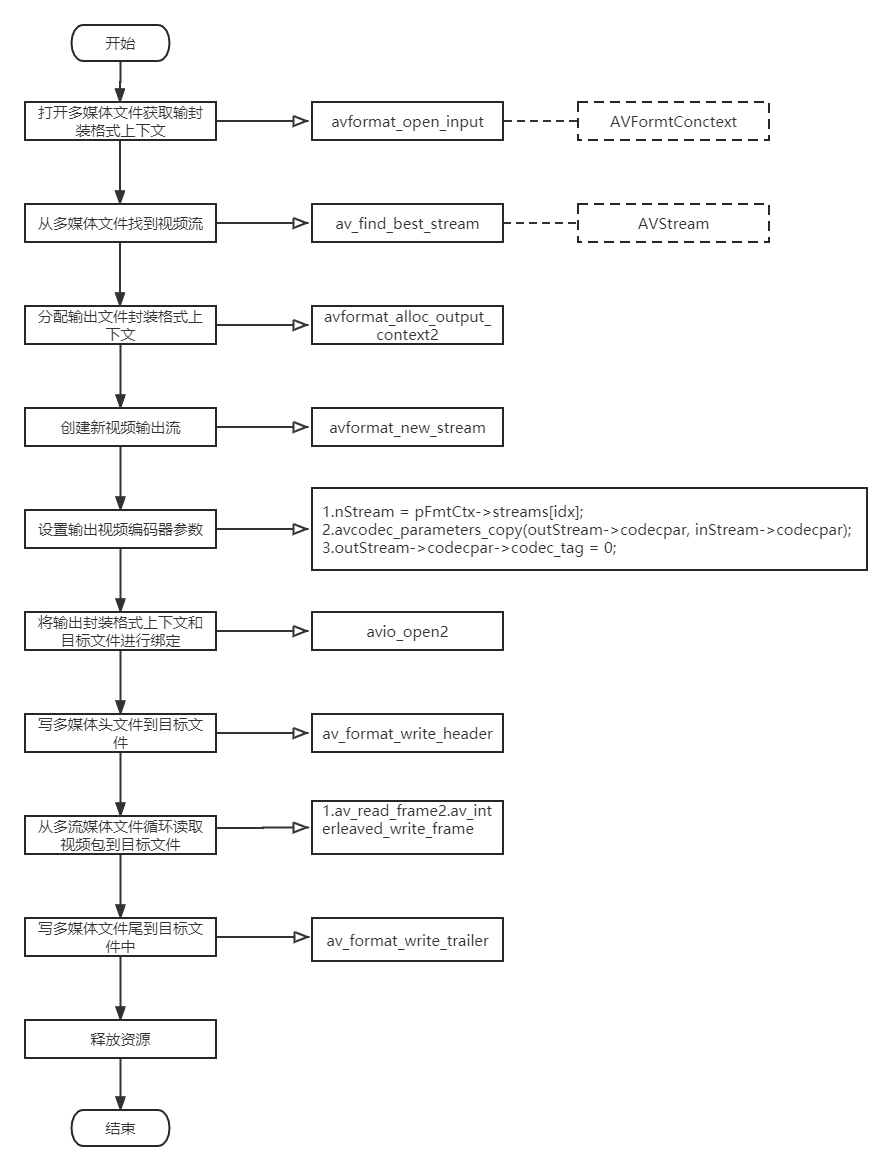和抽取音频数据流程基本一致。主要区别在于读取媒体流的类型和时间基计算DTS和PTS。
一般步骤为:
- 打开多媒体文件
- 从多媒体文件中找到视频流
- 打开目的文件的上下文
- 为目的文件,创建一个新的视频流
- 设置输出视频参数
- 写多媒体文件头到目的文件
- 从源多媒体文件中读取音/视频数据到目的文件中
- 写多媒体文件尾到文件中
- 将申请的资源释放掉
流程图如下:

实现代码:
从一个MP4文件中,抽取视频数据输出为h264视频文件。
#include <stdio.h>
#include <libavutil/log.h>
#include <libavutil/avutil.h>
#include <libavformat/avformat.h>
#include <libavcodec/avcodec.h>
#include <libavformat/avio.h>
#include <libavutil/opt.h>
#include <SDL.h>
#include <stdbool.h>
void getVideo() {
int ret = -1;
int idx = -1;
//1. 处理一些参数;
char* src;
char* dst;
AVFormatContext* pFmtCtx = NULL;
AVFormatContext* oFmtCtx = NULL;
const AVOutputFormat* outFmt = NULL;
AVStream* outStream = NULL;
AVStream* inStream = NULL;
AVPacket pkt;
av_log_set_level(AV_LOG_DEBUG);
src = "F:\\test_data\\crop_jiuzhe_summer.mp4";
/*
* 通常情况下,.h264 文件都是压缩后的裸数据文件,并不包含视频封装格式信息,因此也被称为裸流文件。
裸流文件中只包含编码后的码流数据,不包含任何音视频格式信息,如帧率、分辨率、采样率、声道数、颜色空间等信息。
*/
dst = "F:\\test_data\\crop_jiuzhe_summer.h264";
//dst = "F:\\test_data\\crop_jiuzhe_summer.flv";
//2. 打开多媒体文件
if ((ret = avformat_open_input(&pFmtCtx, src, NULL, NULL)) < 0) {
av_log(NULL, AV_LOG_ERROR, "%s\n", av_err2str(ret));
exit(-1);
}
//3. 从多媒体文件中找到视频流
idx = av_find_best_stream(pFmtCtx, AVMEDIA_TYPE_VIDEO, -1, -1, NULL, 0);
if (idx < 0) {
av_log(pFmtCtx, AV_LOG_ERROR, "Does not include audio stream!\n");
goto _ERROR;
}
//4. 打开目的文件的上下文
oFmtCtx = avformat_alloc_context();
if (!oFmtCtx) {
av_log(NULL, AV_LOG_ERROR, "NO Memory!\n");
goto _ERROR;
}
outFmt = av_guess_format(NULL, dst, NULL);
oFmtCtx->oformat = outFmt;
//5. 为目的文件,创建一个新的视频流
outStream = avformat_new_stream(oFmtCtx, NULL);
//6. 设置输出视频参数
inStream = pFmtCtx->streams[idx];
avcodec_parameters_copy(outStream->codecpar, inStream->codecpar);
outStream->codecpar->codec_tag = 0;
//绑定
ret = avio_open2(&oFmtCtx->pb, dst, AVIO_FLAG_WRITE, NULL, NULL);
if (ret < 0) {
av_log(oFmtCtx, AV_LOG_ERROR, "%s", av_err2str(ret));
goto _ERROR;
}
//7. 写多媒体文件头到目的文件
ret = avformat_write_header(oFmtCtx, NULL);
if (ret < 0) {
av_log(oFmtCtx, AV_LOG_ERROR, "%s", av_err2str(ret));
goto _ERROR;
}
//8. 从源多媒体文件中读到视频数据到目的文件中
while (av_read_frame(pFmtCtx, &pkt) >= 0) {
if (pkt.stream_index == idx) {
// 时间基计算,dts音频和视频不同, 对于音频来说没有B帧 音频的pts=dts 视频有B帧,dts和pts 值不同,单独计算。
pkt.pts = av_rescale_q_rnd(pkt.pts, inStream->time_base, outStream->time_base, (AV_ROUND_NEAR_INF | AV_ROUND_PASS_MINMAX));
pkt.dts = av_rescale_q_rnd(pkt.dts, inStream->time_base, outStream->time_base, (AV_ROUND_NEAR_INF | AV_ROUND_PASS_MINMAX));
pkt.duration = av_rescale_q(pkt.duration, inStream->time_base, outStream->time_base);
pkt.stream_index = 0;
pkt.pos = -1;
av_interleaved_write_frame(oFmtCtx, &pkt);
av_packet_unref(&pkt);
}
}
//9. 写多媒体文件尾到文件中
av_write_trailer(oFmtCtx);
//10. 将申请的资源释放掉
_ERROR:
if (pFmtCtx) {
avformat_close_input(&pFmtCtx);
pFmtCtx = NULL;
}
if (oFmtCtx->pb) {
avio_close(oFmtCtx->pb);
}
if (oFmtCtx) {
avformat_free_context(oFmtCtx);
oFmtCtx = NULL;
}
printf("hello, world!\n");
}